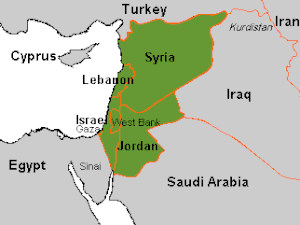This is an old revision of this page, as edited by Macrakis (talk | contribs) at 23:13, 23 September 2011 (remove ELs: Ancient Levant one is just an Amazon agent; Levantinecenter is a social organization. WP is not a Web directory). The present address (URL) is a permanent link to this revision, which may differ significantly from the current revision.
Revision as of 23:13, 23 September 2011 by Macrakis (talk | contribs) (remove ELs: Ancient Levant one is just an Amazon agent; Levantinecenter is a social organization. WP is not a Web directory)(diff) ← Previous revision | Latest revision (diff) | Newer revision → (diff) "Levantine" redirects here. For Catholics in the Ottoman Empire, see Levantines. For other uses, see Levant (disambiguation) and Names of the Levant.
The Levant (/ləˈvænt/) is the area of Western Asia bounded by the Mediterranean to the west, the Taurus Mountains to the north, the Arabian Desert to the south, and the Syrian Desert to the east. The Levant includes modern Lebanon, Syria, Jordan, Israel and the Palestinian Territories and corresponds roughly to the historic area of Greater Syria. The Levant has been described as the "crossroads of western Asia, the eastern Mediterranean and northeast Africa".
Historically, the Levant encompassed all the "Mediterranean lands east of Italy". The "trade on the Levant" between Western Europe and the Ottoman Empire was of great economic importance. An imprecise term, Levant refers to an area of cultural habitation rather than to a specific geographic region, and its meaning has shifted according to historical and cultural reference and preference.
Etymology
The term Levant, which first appeared in English in 1497, originally meant the East in general. It is borrowed from the French levant 'rising', that is, the point where the sun rises. Similar etymologies are found in Ancient Greek Ἀνατολή (cf. Anatolia) and Germanic Morgenland.
"Capitulations"
The term became current in English in the 16th century, along with the first English merchant adventurers in the region: English ships appeared in the Mediterranean in the 1570s and the English merchant company signed its agreement ("capitulations") with the Grand Turk in 1579 (Braudel).
In 19th-century travel writing, the term incorporated eastern regions under then current or recent governance of the Ottoman empire, such as Greece. In 19th-century archaeology, it referred to overlapping cultures in this region during and after prehistoric times, intending to reference the place instead of any one culture.
Since World War I
When the United Kingdom took over the southern portion of Ottoman Syria in the aftermath of the First World War, some of the new rulers adapted the term "Levantine" pejoratively to refer to inhabitants of mixed Arab and European descent and to Europeans (usually French, Italian or Greek) who had assimilated and adopted local dress and customs.
The French Mandates of Syria and Lebanon, from 1920 to 1946, were called the Levant states. The term became common in archaeology at that time, as many important early excavations were made then, such as Mari and Ugarit. Since these sites could not be classified as Mesopotamian, North African, or Arabian, they came to be referred to as "Levantine."
Since World War II
Today "Levant" is typically used by archaeologists and historians with reference to the prehistory and the ancient and medieval history of the region, as when discussing the Crusades. The term is also occasionally employed to refer to modern or contemporary events, peoples, states or parts of states in the same region, namely Cyprus, Iraq, the Palestinian territories, Israel, Jordan, Lebanon, and Syria (compare with Near East, Middle East, Eastern Mediterranean and Western Asia). Several researchers include the island of Cyprus in Levantine studies, including the Council for British Research in the Levant, the UCLA Near Eastern Languages and Cultures department, and the UCL Institute of Archaeology, the last of which has dated the connection between Cyprus and mainland Levant to the early Iron Age. Currently, a dialect of Levantine Arabic, Cypriot Maronite Arabic, is the most-spoken minority language in Cyprus.
The term "Southern Levant" is sometimes used by archaeologists as an alternative term for Syro-Palestinian archaeology, covering (approximately) the area of the modern states of Israel and Jordan as well as the West Bank and the Gaza Strip.
See also
Notes
- ^ The Ancient Levant, UCL Institute of Archaeology, May 2008
- Oxford English Dictionary, 2nd edition
- Sandra Rosendahl (2006-11-28). "Council for British Research in the Levant homepage". Cbrl.org.uk. Retrieved 2010-07-05.
- Biblical and Levantine studies, UCLA
References
- Braudel, Fernand, The Mediterranean and the Mediterranean World in the Age of Phillip II
- Julia Chatzipanagioti: Griechenland, Zypern, Balkan und Levante. Eine kommentierte Bibliographie der Reiseliteratur des 18. Jahrhunderts. 2 Vol. Eutin 2006. ISBN 3981067428
- Levantine Heritage site. Includes many oral and scholarly histories, and genealogies for some Levantine Turkish families.